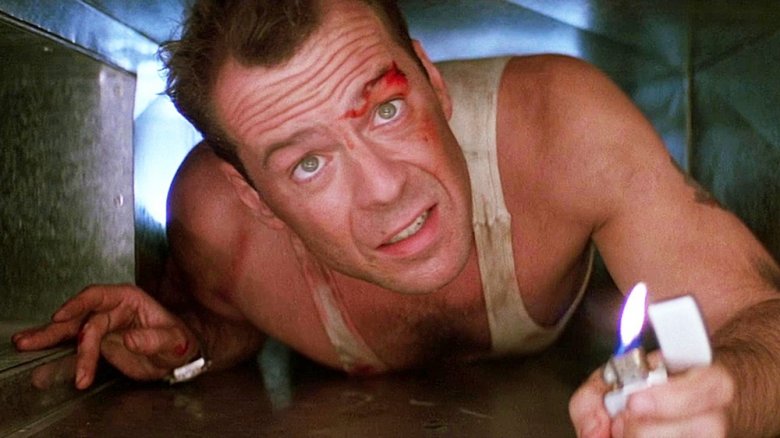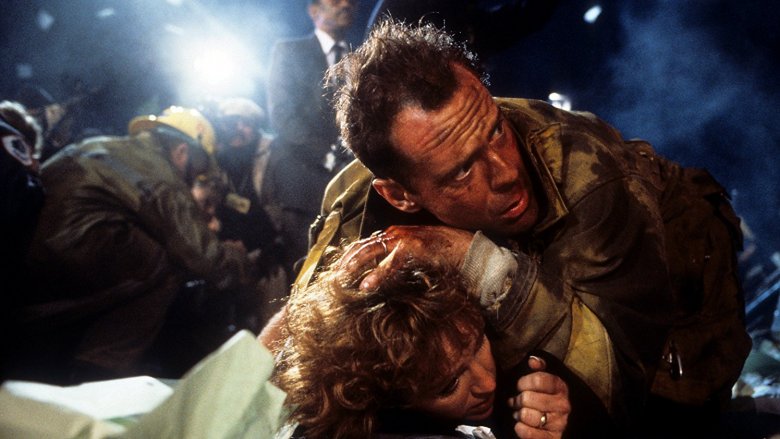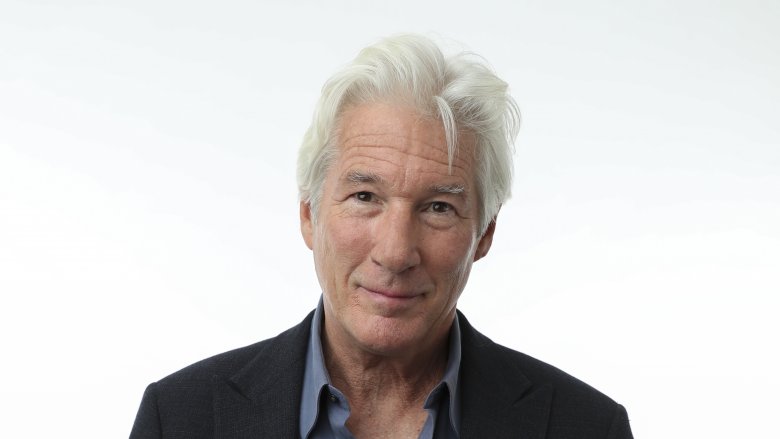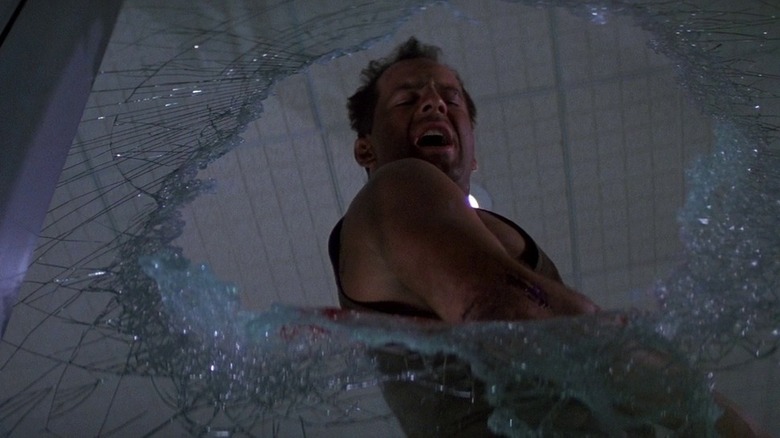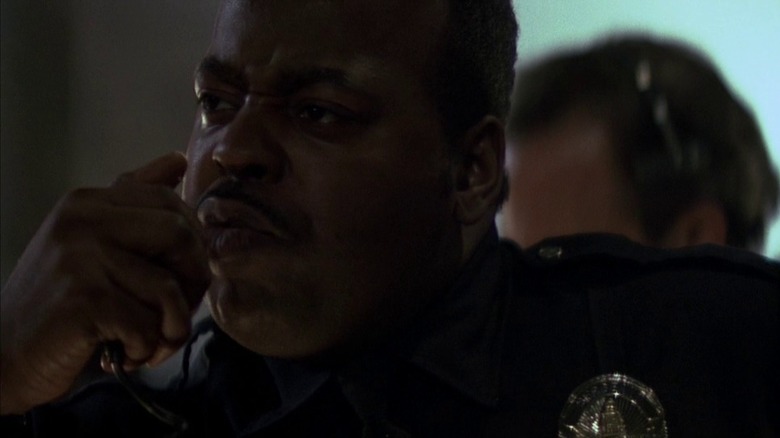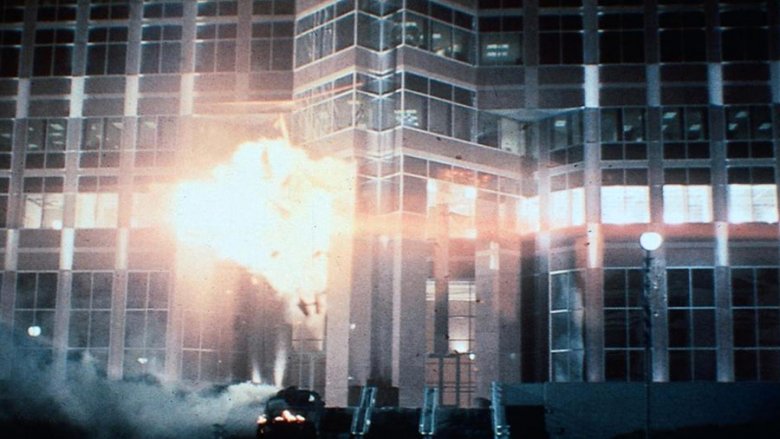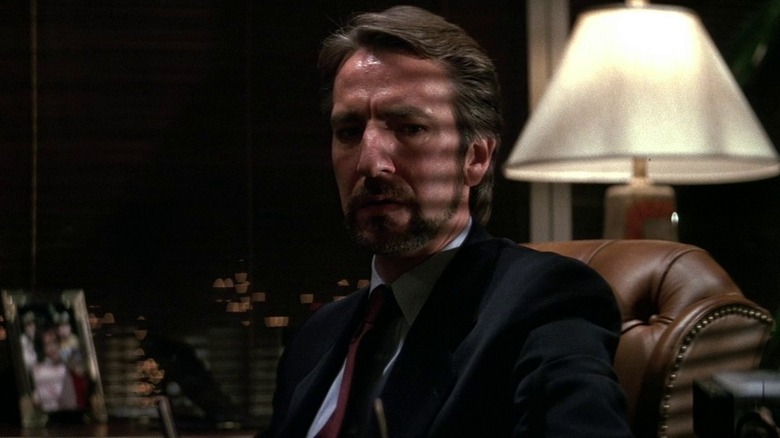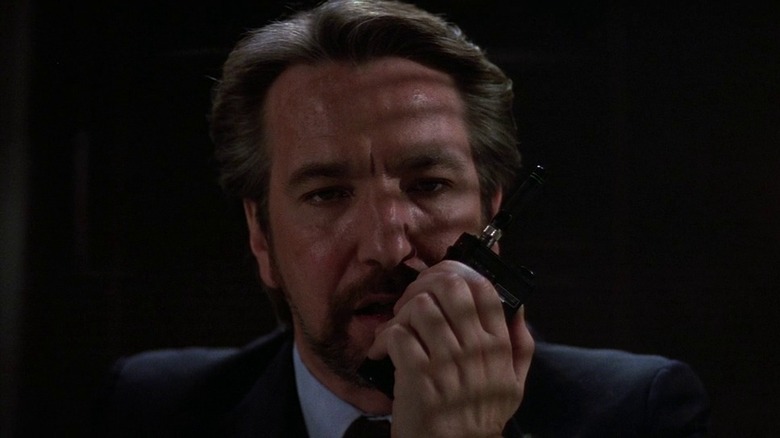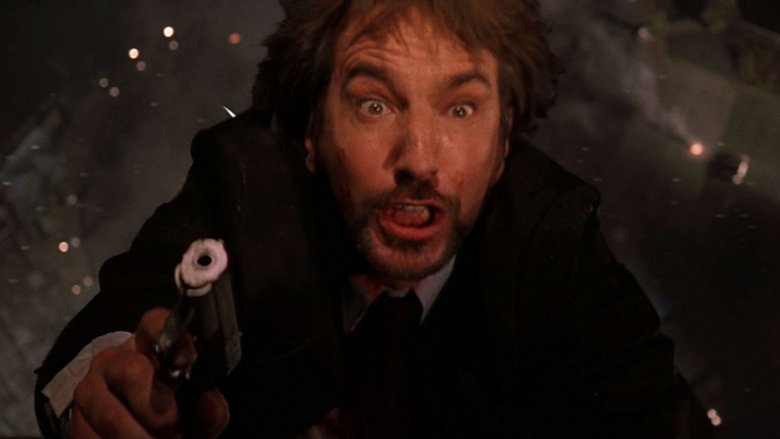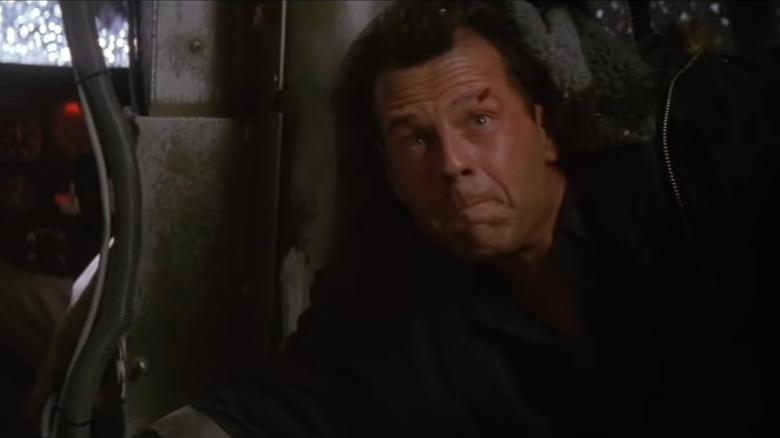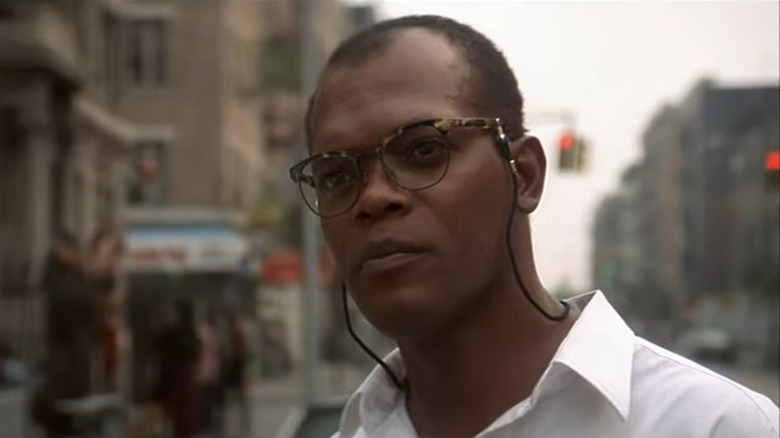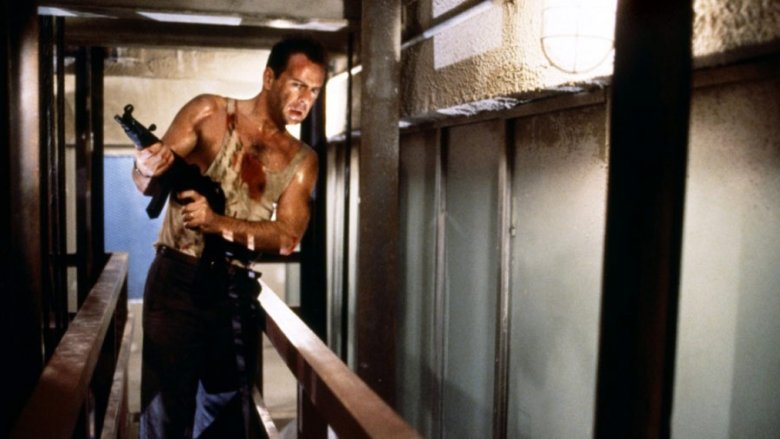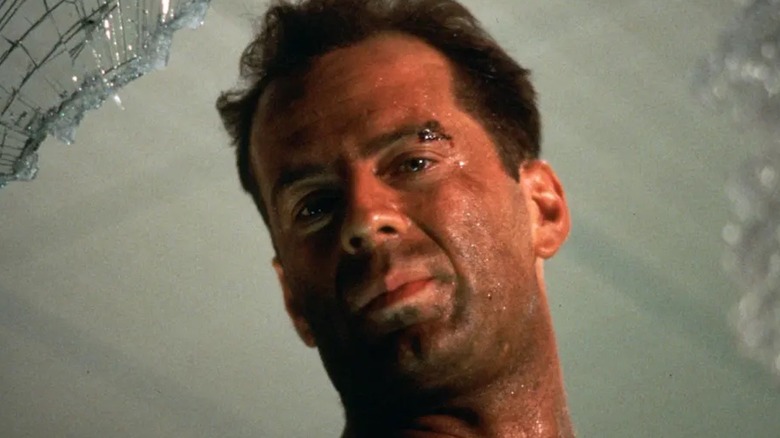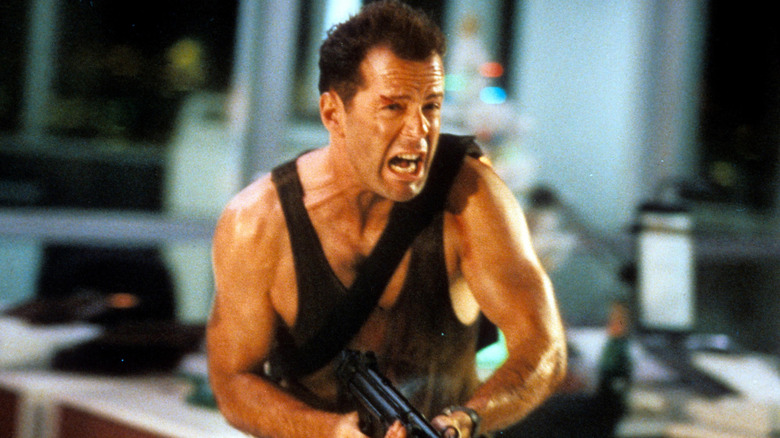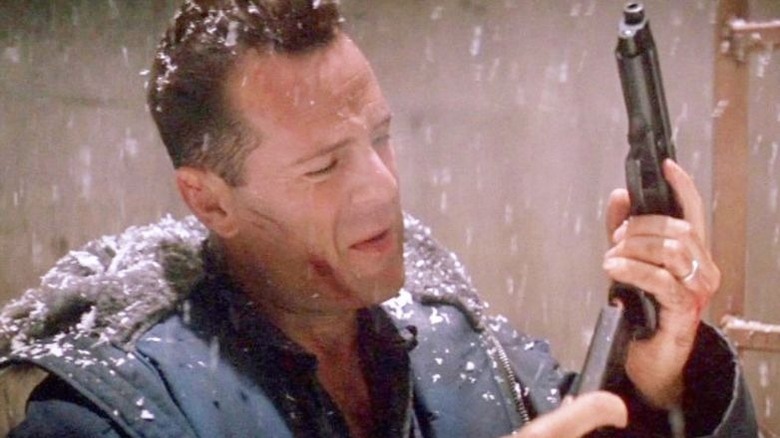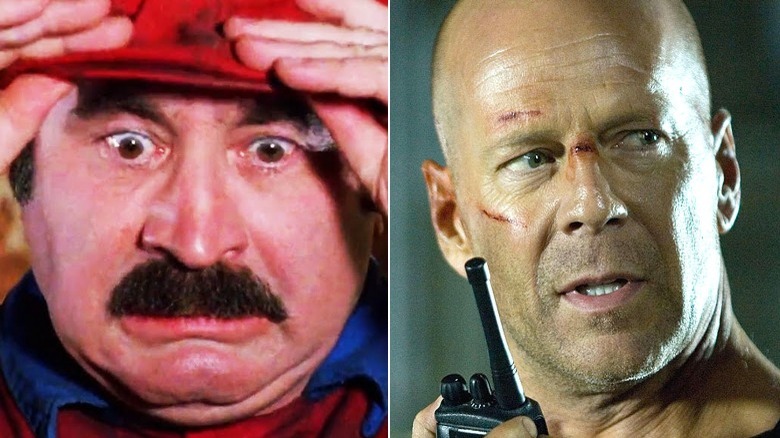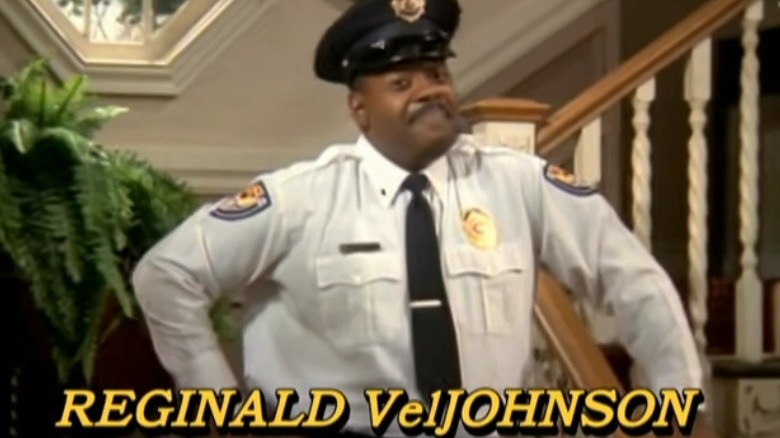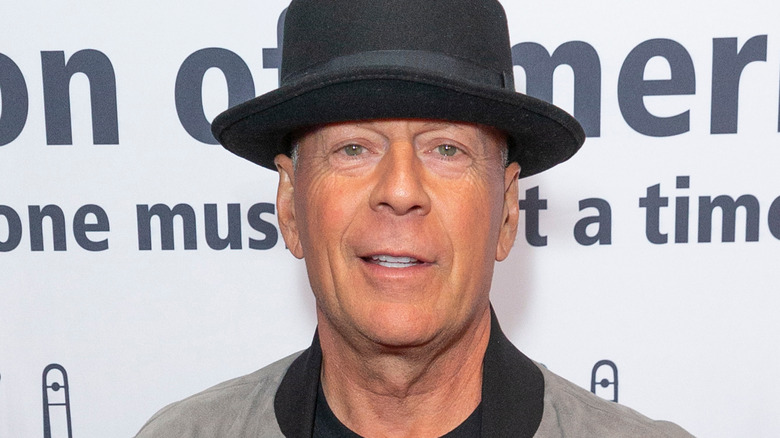The Untold Truth Of Die Hard
When "Die Hard" opened in just 21 theaters on July 15, 1988, the first audiences probably didn't realize they were seeing a future action classic. The Bruce Willis-led film launched a new movie star and a new franchise while skewering tropes of the action genre and providing a purely fun moviegoing experience all at the same time.
For those who aren't familiar with the film, "Die Hard" features Willis as a cop who's unwittingly roped into stopping a group of terrorists while trying to win back his wife at her office Christmas party. Although there's still plenty of debate surrounding whether it's a Christmas movie, there's no denying that it's an action classic — it was named the best action movie of all time by Entertainment Weekly and the 20th greatest movie of all time by Empire.
The incredibly popular film — and the incredibly popular franchise that followed — has spawned quite a few interesting stories and behind-the-scenes tidbits that any fan should check out. Here is the untold truth of "Die Hard."
It didn't start out as a movie
"Die Hard" may not exactly seem like the literary kind of film, but it is actually based on a book — the 1979 novel "Nothing Lasts Forever," by Roderick Thorpe. The story follows a NYPD detective named Joe Leland who takes down a group of terrorists while attending his daughter's company's Christmas party.
The franchise continued to borrow from the literary world as it grew. "Die Hard 2" is based on the 1987 novel "58 Minutes" by Walter Wager, about an NYPD captain who has to stop a group of terrorists who attack JFK. The third film, "Die Hard with a Vengeance," wasn't based on a book, but was an adaptation of the spec script "Simon Says," which was initially considered as a potential entry into the "Lethal Weapon" franchise.
For the fourth movie, the filmmakers didn't look into the literary sphere, but instead went to Wired magazine, pulling from their 1997 article "A Farewell to Arms" by John Carlin. 2013's "A Good Day to Die Hard," written by Skip Woods ("X-Men Origins: Wolverine"), wasn't inspired by another work, but was actually written after Willis called Woods with the idea for the story, which revolves around rescuing McClane's son.
No one wanted to play John McClane
It isn't always easy to cast a movie, and producers definitely found that was the case as they tried to nail down a lead for "Die Hard." A slew of action stars turned down the role before it finally went to Willis, including Richard Gere, Arnold Schwarzenegger, Sylvester Stallone, James Caan, and Burt Reynolds.
"All of these people rejected it because, remember, this is 1987," said Steven E. de Souza (per The Daily Beast). "You had all these 'Rambo' movies. We've had 'Commando,' 'Predator,' and in the wake of all of these, the hero, they said, was like a p****. The reaction? 'This guy's no hero.'" According to de Souza, it was "in desperation" that they finally went to Willis.
One other big name was said to have been attached to the role as well — Frank Sinatra. Sinatra starred in a 1968 adaptation of Thorp's novel "True Detective," which predated "Nothing Lasts Forever." Because he had previously played the lead character, the studio was reportedly contractually obligated to offer him the role again, despite the fact that he was 73 years old at the time. That obviously didn't pan out, and Sinatra's loss became Willis' gain.
A massive payday
Although Willis is a superstar today, before "Die Hard" was released, he was mostly known for his work on ABC's hit series "Moonlighting," which won him a Golden Globe in 1987. At the time, the movie and TV worlds were much more separate, and a TV star wasn't likely to get much for appearing in a film. Still, Willis' agent Arnold Rifkin knew his worth, and demanded a massive (for the time) $5 million salary for his starring role.
Fox kept coming back with smaller offers, but Rifkin stuck to his guns, and eventually they agreed. "He got the astonishing sum of $5 million, which made everybody's salaries in Hollywood [increase] the next day," said de Souza. "Literally, the next day Richard Gere said, 'How did this guy get $5 million, which is more than I got from my last picture and I've been nominated for awards?'"
The bet didn't seem to work out for the studio at first. The movie opened in wide release to $7.1 million, and research showed that Willis wasn't a favorite with audiences. Because of this, the studio kept him out of parts of their ad campaign, featuring the Nakatomi Plaza in a newspaper ad instead of their star. Still, the movie ultimately became a hit, and it clearly ended up working out for Willis as well as the studio.
The untold truth of Al Powell
Just as they did while casting John McClane, producers thought of a few different actors before landing on Reginald VelJohnson to play the LAPD cop Sergeant Al Powell. According to casting director Jackie Burch, the producers and director John McTiernan were originally looking at legendary actor Robert Duvall to play the part of McClane's confidant.
"I'm in there saying, 'I'm the only woman in the room, and I'm telling you it's Reginald VelJohnson,'" Burch recalled. "”He's someone I've hired before. He's the nicest man you'll ever meet, and you need him just the way Bonnie Bedelia is an asset for Bruce.' Everyone around Bruce just grounded him more because, you know, he could be cocky ... So having her on one side and Reginald on the other was really good chemistry and the right match for Bruce."
McTiernan, for his part, has said he doesn't remember pushing for Duvall, but he does remember hoping for another up-and-coming star — Laurence Fishburne, then known as Larry. Although it's unclear if he ever approached Fishburne about the role, the actor was later up for another part in the franchise — Zeus in "Die Hard with a Vengeance." Fishburne actually sued producers when they gave the role to Samuel L. Jackson instead, alleging that they'd gone back on a verbal agreement.
Foxy Nakatomi Plaza
Nakatomi Plaza is basically its own character in "Die Hard," and if you head out to Los Angeles, you may be a bit surprised to see that the hulking building is actually a real place. The movie's producers utilized the recently completed Fox Plaza, a 35-story skyscraper, to serve as its fictional Nakatomi Plaza.
Fox Plaza would eventually go on to become the home of Ronald Reagan's offices after his time in the White House — and when Reagan's chief of staff Fred Ryan toured the space, it was actually covered in bullet shells and broken glass from the production of "Die Hard." A Secret Service agent reportedly joked about the eventual choice, saying, "Great, you just picked a building where there's been a movie made about how terrorists can blow it up."
Having the space reserved for the former president made for some interesting times during filming. "The brass was like, 'Wait a minute. What's this?'" de Souza said (per Thrillist) of the staffers coming in to find "bullets and empty cartridges all over the place ... For a couple of hours they're wondering like, 'Did somebody do a drive-by in here?' Then they realized what it was." Editor Frank Urioste added that the FBI, who hadn't been notified about the filming earlier, "thought it looked like a terrorist attack." Whoops.
Hans Gruber's telltale watch
Audiences have long questioned just how McClane figured out that Hans Gruber was actually a terrorist when he disguised himself as a hostage. Although many people just chalked it up to police instinct, de Souza cleared up this questionable plot point in an interview nearly 30 years after its release, saying McClane realized Gruber's criminal leanings thanks to his watch.
According to de Souza, there was originally a scene just before the terrorists entered the building in which Gruber told all of them to synchronize their watches, showing that they all had the same Tag Heuer timepiece. When McClane kills the first terrorist, he searches the body and notices the watch; as he continues on in his spree, he continues to notice that all the bad guys are wearing the same one.
However, the whole plan ended up falling apart due to de Souza's last-minute idea to have the terrorists plan to escape in an ambulance. There was no ambulance visible in the "synchronize your watches" scene, forcing them to cut it and leaving a hole in the plot. If you look at the final product, though, you can still see the filmmakers' original intention, with McClane glancing at Hans' watch when he offers him a cigarette.
Hans Gruber, protagonist?
Alan Rickman's Hans Gruber is a classic villain, but de Souza didn't view him as such when he was writing the movie. De Souza revealed in an interview with Creative Screenwriting that one of the more important things for him in writing an action movie is to look at the villain as the protagonist, not the hero.
"If you're writing the kind of pictures I do, and you find that you're stuck, it may be because you're spending too much time in the head of your hero," he said. "If you're doing that, it's because you may have the mistaken impression that the hero of your story is the protagonist. If you're doing genre, the protagonist is the villain."
De Souza explained that Gruber is actually the protagonist of "Die Hard" because he planned the robbery that set the events of the movie in motion. "If he had not planned the robbery and put it together, Bruce Willis would have just gone to the party and reconciled or not with his wife," he said. "You should sometimes think about looking at your movie through the point of view of the villain who is really driving the narrative." Solid screenwriting advice — and also something that might make some audiences reevaluate the film.
Rickman's real fear
Hans Gruber finally gets his due at the end of "Die Hard," and the character's memorable death scene has gone down in history as one of the movie's greatest moments. The fear that you see on Gruber's face in that scene, though, isn't just Rickman being a great actor — it's because the star was legitimately terrified.
Rickman filmed the scene attached to a rig called "The Decelerator." The actor said that he shocked producers by offering to do the 40-foot fall himself. They practiced dropping him a few feet at first onto an air bag, eventually working their way up to the full height. In all of their practicing, they dropped him on the count of three, but in the real take, stunt coordinator Charlie Picerni said to drop him on one.
"You'd break your back, especially if you were untrained, but this is the thing about it: what you see on his face when he lets go is real fear," said production designer Jackson De Govia. "It's one of the greatest shots ever. He was terrified. Any of us would be. You saw a fear of death, and I think, as an actor, he just let his emotions go. He let us see what he was feeling, and it was a tremendous shot."
Die Hard 2 disagreements
"Die Hard 2" upped the stakes of the first film by forcing McClane to stop a terrorist from crashing a plane with 230 people on board. However, unlike his success in the first movie, McClane fails at his goal, resulting in the loss of the plane and the deaths of everyone on board.
The scene showed the futility of McClane's efforts and was hugely important to the film, but the studio actually pushed for it to be removed. De Souza, who also penned the script for the second film, revealed that the studio filmed an alternate scene in which a model UPS plane crashed, killing just two people instead of 230.
"The studio insisted," de Souza said. "They said, 'You can't kill all those people. We'll lose the audience. It has to be a UPS plane.'" However, test audiences "loved" the film with the original plane crash scene, so they kept it in. "For a while," added de Souza, "if you didn't count George Lucas blowing up Princess Leia's planet, that was the highest body count movie because of the plane crash with imaginary people in it."
Die Hard with an FBI Interrogation
"Die Hard with a Vengeance" brought in audiences at the box office, but it also brought questions from the FBI. Screenwriter Jonathan Hensleigh revealed in the DVD commentary for the film that he was actually interrogated by the bureau about his knowledge of the Federal Reserve Bank and his villains' fictional plot to rob it.
"When the script was being vetted by all the authorities in New York, obviously the New York Police Department had to read the script for a number of reasons," he said. "One day I got a call from the FBI. They were extremely concerned about how I knew so much about the Federal Reserve, and how the Federal Reserve's vaults were really close to a subway spur, and logistically about the aqueduct tunnel, et cetera."
Hensleigh told the FBI that the reason he was so familiar with the vault was simple: the bank let them see it. "They showed it to us," he said. "So I'm really not employed by Afghani terrorists. I really don't have any kind of secret proprietary knowledge that I shouldn't have."
Although the FBI let Hensleigh off the hook, he did say that the movie made them rethink their security. "This one scene, our FBI guy said, 'You know it sounds crazy, but somebody could actually pull this off. We're going to actually have a sit-down [meeting] and talk about how we can improve the facility so that it could never happen,'" Hensleigh said. "That pleased me, actually."
It hurts to Die Hard
John McClane has been through the gamut of injuries across the "Die Hard" franchise, and so has Willis. The action star revealed that an accident on the set of the first film has left him partially deaf. "I suffer two-thirds partial hearing loss in my left ear," he said, "and have a tendency to say, 'Whaaa?'"
That wasn't his only injury, either. The actor had to be sent to the doctor after receiving a kick just above his right eye while filming a scene with a stunt double for Maggie Q on the set of "Live Free or Die Hard" in 2007. Considering the stunt double was wearing stilettos, the kick had to hurt quite a bit.
Willis was sent home from the doctor that day, and a representative for Fox Studios said that the incident was "no big deal." Still, director Len Wiseman said that it looked pretty serious at the time. "It was all bloody ... and [Willis] pulled the skin back and asked me, 'How bad is it?' and I saw the bone," Wiseman said.
A memorable sequence in Die Hard was a total accident
Arguably, the reason that the original "Die Hard" works so well is because of its engaging premise: John McClane is an everyday, rank-and-file police officer forced to rise to the challenge of thwarting a terrorist plot. The character is nothing like other '80s action movie heroes — stoic and fearless like guys played by Arnold Schwarzenegger, Sylvester Stallone, or Chuck Norris — but actively and consistently terrified as he slowly wages a high-stakes war of defense against Hans Gruber and his goons.
Star Bruce Willis, at this stage in his career, needed a stunt double to perform all the truly death-defying scenes the script required, including the scene where McClane gathers up the nerve to leap into an elevator shaft. The stunt performer was supposed to jump and grab onto a vent, but instead he missed by a potentially fatal amount. He saved his own life by holding on to another, fortuitously placed vent. Although that was an accidental action and technically an outtake, that footage made it into the final cut of "Die Hard," according to director John McTiernan's "Die Hard" commentary track (via Film School Rejects).
Yippee-ki-yay, it's the story of an immortal catchphrase
Among the many elements that made "Die Hard" such an unstoppable classic is its dialogue, a lot of it motivational self-directed grumblings of John McClane. The most memorable of all, however, is his personal call to action: "Yippee-ki-yay, m***********!" Delivered in multiple "Die Hard" movies in order to meet audience expectation, Bruce Willis first said the line in the first film in the series back in 1988, and it was entirely improvised, a lark the actor thought wouldn't live past the day he made the quip. "It was a throwaway," Willis revealed in 2013 on "On Air with Ryan Seacrest" (via The TimesOnline). "I was just trying to crack up the crew, and I never thought it was going to be allowed to stay in the film."
While it was too good of a line to remove from the movie, or not include in future "Die Hard" installments, the most prominent "Die Hard" media where the catchphrase doesn't appear is in the sanitized-for-broadcast cut of the first film. When the movie aired on TBS, John McClane's totally cool utterance was removed of its bite and profanity, turned into the nonsensical "Yippee-ki-yay, Mr. Falcon!"
A cut Die Hard 2 scene led to a lawsuit
The first "Die Hard" was a sleeper hit, building up huge demand — a potentially huge audience of paying customers — for the sequel, "Die Hard 2: Die Harder," which hit theaters in 1990. According to the Associated Press, toolmaker Black & Decker seized the opportunity by hiring marketing company Krown-Young & Rubicam to arrange a prominent product placement for one of its cordless drills. The "Die Hard 2" connection was supposed to be a lynchpin in a larger marketing campaign, promoting the drills around the time of the film's release which coincided with the Father's Day gift-purchasing segment of the retail calendar.
The scene called for John McClane to take the grill off of an air duct in an airport tunnel with the Black & Decker drill, but then filmmakers cut the sequence from the final cut of the film. That prompted Black & Decker to sue producer 20th Century Fox and Krown-Young & Rubicam for ignoring their product placement agreement, asking for damages of $150,000 along with interest and court costs. The matter, which according to the Michigan Film Office was the first ever product placement lawsuit, was later quietly settled out of court.
John McClane almost became the third Mario brother
After the first two "Die Hard" movies but before the release of "Die Hard with a Vengeance," another high stakes action movie about workaday guys defeating a seething, hostage-taking uber-villain hit theaters — but it wasn't nearly as well regarded as the Bruce Willis franchise. In 1993, "Super Mario Bros.," a dystopian sci-fi action comedy thriller extremely loosely based on the bestselling video game franchise, arrived in multiplexes (and then quickly departed, as it was a critically savaged box office bomb).
According to GameInformer, Nintendo gave screenwriters a creative blank check. "Nintendo let us do whatever we wanted," director Rocky Morton said. That in part led to a plot that involved some very non-Mario elements, like a dinosaur-inhabited version of New York called Dinohattan, a foreboding dystopian vibe, and a scripted cameo from Bruce Willis, in character as John McClane from "Die Hard." One round of frantically produced rewrites led to a scene in bad guy King Koopa's skyscraper, with a scene of Willis (as McClane) crawling through the air ducts about the dinosaur-man's office. According to the script, Mario and Luigi are in the ducts and run into McClane, who helpfully tells the lost plumber duo "Other way." Unfortunately, that scene was never shot, so it didn't make it into "Super Mario Bros."
Is Die Hard connected to Ghostbusters and Family Matters?
Apart from Bruce Willis, the actor most associated with the "Die Hard" series is Reginald VelJohnson, who portrayed Sgt. Al Powell in the first two films, as well as in a couple of video game spinoffs. The prolific character actor often plays law officers of some type, like he did in three enduringly popular 1980s and 1990s entertainments — in addition to Sgt. Powell in "Die Hard," VelJohnson portrayed "Jail Guard" in the first "Ghostbusters" movie and then Chicago beat cop Carl Winslow for nine seasons of the sitcom "Family Matters."
According to Cracked, a fan theory attests that all three characters are actually the same character, at different points in his life. In "Ghostbusters," VelJohnson's prison guard brings the titular scientists to the major's office and then, theoretically, after witnessing the deeply disturbing paranormal activity that rips New York City apart, he retreats to Los Angeles and joins the police force, where he endures the traumatic experience of thwarting a terrorist takeover of Nakatomi Plaza. That sends the officer spiraling again, prompting another move, this time to a relatively quiet police job in Chicago.
Die Hard 6 died quietly
The box office take for the fifth film in the franchise, 2013's "A Good Day to Die Hard," dipped below that of its predecessors, "Live Free or Die Hard" and "Die Hard With a Vengeance," but filmmakers and star Bruce Willis weren't totally ready to let John McClane enjoy a peaceful retirement. In a February 2018 appearance on "The Tonight Show" (via Den of Geek), Willis confirmed that a sixth "Die Hard" film was on the way. News reports at the time suggested that "A Good Day to Die Hard" director Len Wiseman would return to oversee "Die Hard: Year One," a 1970s-set prequel to the whole McClane saga that would also feature a present-day Willis reprising his role in a few scenes. "I'm about to wing out to California to start to see what the script looks like," Willis said of the movie.
Unfortunately for fans of the series, another "Die Hard," at least one involving Willis, is extremely unlikely to happen at this point in time. In 2021, "Die Hard" producer Lorenzo di Bonaventura told Polygon that the Fox-branded movie was canceled after Disney acquired that movie studio. In a more tragic development, Willis announced his retirement from acting in March 2022, following a diagnosis of aphasia, a brain disorder that impacts communication abilities.
While "Die Hard" fans may not get treated to another film, all of the movies are available on various streaming platforms.
